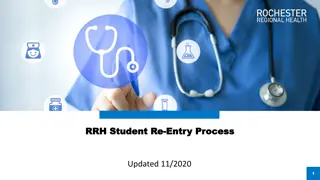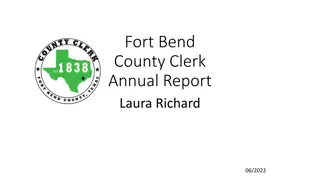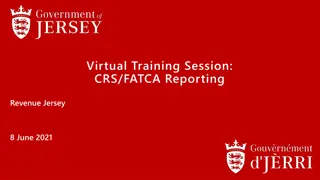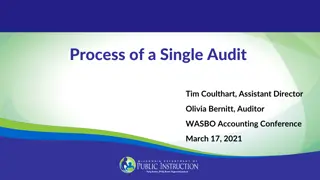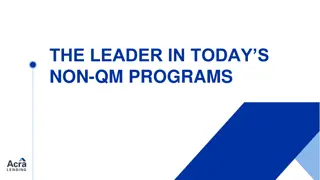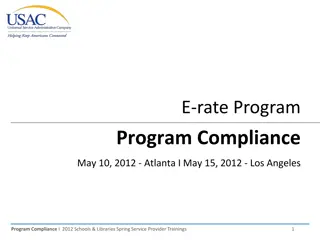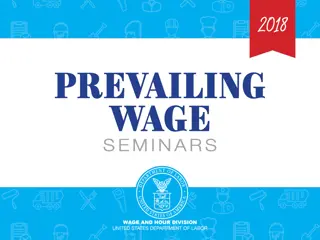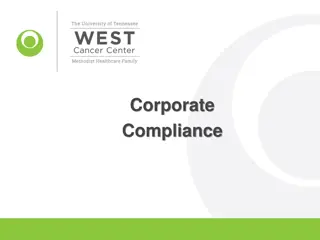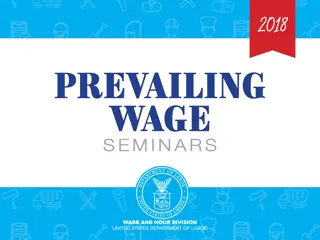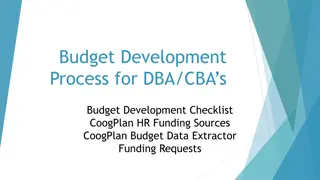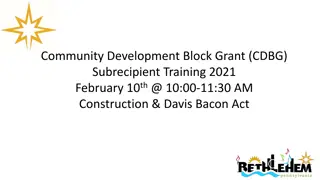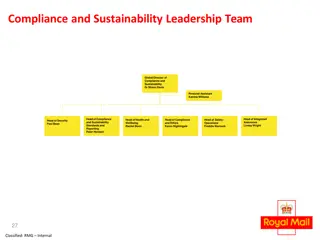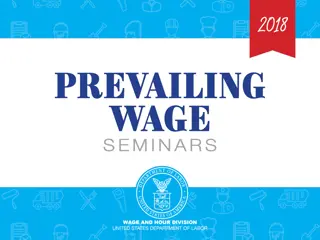Understanding DBA and DBRA Compliance Principles
Explore the key principles of compliance related to the Davis-Bacon Act (DBA) and Davis-Bacon Related Acts (DBRA), covering topics such as laborers and mechanics, fringe benefits, site of work, deductions, and certified payrolls. Learn about the classification of work and the definition of laborers and mechanics under these acts. Understand the scope and definitions of the site of work, including what it includes and excludes. Gain insights into the application of DBA and DBRA to workers directly involved in construction projects.
Download Presentation

Please find below an Image/Link to download the presentation.
The content on the website is provided AS IS for your information and personal use only. It may not be sold, licensed, or shared on other websites without obtaining consent from the author. Download presentation by click this link. If you encounter any issues during the download, it is possible that the publisher has removed the file from their server.
E N D
Presentation Transcript
DBA/DBRA Compliance Principles Laborers and mechanics Fringe Benefits Site of the work Deductions Classification of Work Certified Payrolls
Laborers and Mechanics Workers whose duties are manual or physical in nature; Includes apprentices, trainees and helpers; and For CWHSSA, includes guards and watchmen.
Laborers and Mechanics Does not include: Timekeepers, inspectors, architects, engineers; or Bona fide executive, administrative, and professional employees as defined under FLSA. Working foremen are generally non-exempt: must be paid the Davis Bacon (DB) rate for the classification of work performed if not 541 exempt.
Site of the Work Davis-Bacon applies only to laborers and mechanics employed directly on the site of the work. A three-part definition applies to determine the scope of the term site of the work.
Site of the Work Definition 1 DBA applies only to workers directly on the site of the work: The physical place or places where the construction called for in the contract will remain after work has been completed; and Any other site where a significant portion of the building or work is constructed, provided that such site is established specifically for the contract.
Site of the Work Definition 2 Site of the work also includes job headquarters, tool yards, batch plants, borrow pits, etc., provided they are: Located adjacent or virtually adjacent to the site of the work described in paragraph 1; and Dedicated exclusively or nearly so to the performance of the contract or project. Except if they are excluded see next slide
Site of the Work Definition 3 Site of the work does not include a contractor s or subcontractor s: permanent home office, branch locations, fabrication plants, tool yards, etc.; whose location and continuance in operation are determined without regard to a particular covered project.
Definition 3 (Contd.) Also not included in the site of the work are: Fabrication plants, batch plants, job headquarters, tool yards, etc., of a commercial supplier established by a supplier of materials: - Before the opening of bids for a project; and - Not located on the actual site of the work. Such permanent, previously established facilities, are not part of the site of the work, even where the operations for a period of time may be dedicated exclusively, or nearly so, to the performance of a contract.
Truck Drivers Truck drivers of the contractor or subcontractor are covered by Davis-Bacon for time: Spent working on the site of the work; and/or Spent loading or unloading materials and supplies on the site of the work, if such time is more than de minimis. (Slides coming up discuss material suppliers.)
Truck Drivers Truck drivers are also covered when: Transporting materials and supplies between a facility that is part of the site of the work and the actual construction site; or Transporting portions of a building or work between a site where a significant portion of the project is being constructed and the physical place where the building or work will remain.
Truck Drivers Owner-Operators DOL has an enforcement position with respect to bona fide owner-operators of trucks who are independent contractors (an owner-operator is a person who owns and drives a truck). Certified payrolls including the names of such owner- operators do not need to show the hours worked or the rates paid, only the notation owner- operator. This position does not apply to owner-operators of other equipment such as bulldozers, cranes, etc.
Material Suppliers The manufacture and delivery to the work site of supply items such as sand, gravel, and ready-mixed concrete by bona fide material suppliers, are activities not covered by DBA/DBRA requirements (even though the materials are delivered directly into a contractor s work site mixing facilities). Bona fide material suppliers (including truck drivers) whose only contractual obligations for on-site work are to deliver materials and/or pick up materials are not considered contractors under the DBA/DBRA. Thus, their employees are not subject to the Davis-Bacon labor standards.
Material Suppliers (contd.) However, laborers and mechanics employed at the site of the work by a material supplier, manufacturer, or carrier that undertakes to perform a part of a construction contract as a subcontractor: Would be subject to Davis-Bacon labor standards in the same manner as those employed by any other contractor or subcontractor. For enforcement purposes, if such a worker spends more than an incidental amount (20%) of his/her time in a workweek engaged in construction work on the site, he/she is covered for all time spent on the site during workweek.
Wages & Fringe Benefits All laborers and mechanics employed or working upon the site of work must be paid at least the applicable prevailing wage rate for the classification of work performed, without regard to skill.
Wages & Fringe Benefits Laborers or mechanics performing work in more than one classification may be compensated at the rate specified for each classification for the time actually worked therein: Provided, That the employer's payroll records accurately set forth the time spent in each classification in which work is performed. 29 CFR 5.5(a)(1)
Wages & Fringe Benefits DBA: the terms wages and prevailing wages include: The basic hourly rate (BHR); Contractor contributions irrevocably made to a trustee or third party pursuant to a bona fide fringe benefit (FB) fund, plan, or program; and/or The rate of costs the contractor reasonably anticipates in providing bona fide FB s where certain conditions are met.
Wage & Fringe Benefits Under DBA, FB s are a component of the DBA prevailing wage. The prevailing wage obligation may be satisfied by: Paying the BHR and FB in cash (including negotiable instruments payable on demand); Contributing payments to a bona fide plan; or Any combination of the two.
Wages & Fringe Benefits Must be paid weekly for all hours worked: Unless the fringe benefits are paid into a bona fide FB plan and then contributions must be paid no less often then quarterly. Cash wages paid in excess of BHR may count to offset or satisfy the FB obligation (unlike under SCA).
Prevailing Wage Example BHR FB $ 1.00 Total prevailing wage $15.00 $14.00 The contractor may comply by paying: $15.00 in cash wages $14.00 in cash wages plus $1.00 for FB $12.00 in cash wages plus $3.00 for FB
Prevailing Wage Example An employee spent 32 hours working as an electrician, with a BHR of $22.00 and an FBR of $3.00, and 8 hours working as a laborer, with a BHR of $14.00 and a FBR of $1.00. The employee is due $800.00 for his electrician work (32 hours X ($22.00 + $3.00)) and $120.00 for his laborer work (8 hours X ($14.00 +$1.00)), for a total of $920.00. The $920.00 can be paid in any combination of cash wages and fringe benefit contributions.
Deductions 29 CFR 3.5 lists deductions that an employer can make from the prevailing wage rate without the approval of the Secretary of Labor. Examples include Social Security and federal or state taxes, certain court-ordered payments, bona fide pre-payments of wages, certain payments of union dues, and voluntary charitable donations.
Deductions 29 CFR 3.6 generally provides that the Secretary may approve other deductions whenever all of the following conditions are met: The contractor does not profit directly or indirectly from the deduction The deduction is not otherwise prohibited by law Either the employee voluntarily consented to the deduction in writing in advance of the time that the work was performed or the deduction is under the terms of a collective bargaining agreement The deduction serves the convenience and interest of the employee
Payroll and Basic Records Payrolls and related basic records shall be maintained by the contractor during the course of the work and for three years thereafter for all laborers and mechanics working at the site of the work. Such records shall contain the name, address, and social security number of each such worker, his or her correct classification, hourly rates of wages paid (including rates of contributions or costs anticipated for bona fide fringe benefits or cash equivalents thereof of the types described in section 1(b)(2)(B) of the Davis- Bacon Act), daily and weekly number of hours worked, deductions made and actual wages paid. 29 CFR 5.5(a)(3)
Certified Payrolls Regulatory Provisions at 29 C.F.R. Part 3; & 29 C.F.R. 5.5(a)(3), (5), and (8), reiterated at FAR 48 C.F.R. 52.222-8, 52.222-10 and 52.222-13 Davis-Bacon contract clause provisions: Payrolls and basic records : 29 C.F.R. 5.5(a)(3) Applicability of 29 C.F.R. Part 3: 29 C.F.R. 5.5(a)(5) & (8). Provisions in 29 C.F.R. Part 3: 29 C.F.R. 3.3 Weekly statement with respect to payment of wages 29 C.F.R. 3.4 Submission of weekly statements and the preservation and inspection of weekly payroll records.
Certified Payrolls Two separate contract clause requirements apply to certified payrolls for a project: The contractor shall submit weekly for any week in which any contract work is performed a copy of all payrolls. 29 C.F.R. 5.5(a)(3)(ii)(A). Each weekly payroll submitted must be accompanied by a Statement of Compliance. 29 C.F.R. 5.5(a)(3)(ii)(B).
Certified Payrolls Weekly payrolls must include specific information as required by 29 C.F.R. 5.5(a)(3). Weekly payroll information may be submitted in any form desired. Optional Form WH-347 is available for this purpose The WH-347 form, with instructions, is at: http://www.dol.gov/whd/forms/wh347instr.htm.
WHD Internet Sites Wage Determinations http://www.wdol.gov Wage and Hour Division - http://www.dol.gov/whd/index.htm Resource Book - http://www.dol.gov/whd/recovery/pwrb/toc.htm Office of the Administrative Law Judges Law Library - http://www.oalj.dol.gov Administrative Review Board - http://www.dol.gov/arb
Disclaimer This presentation is intended as general information only and does not carry the force of legal opinion. The Department of Labor is providing this information as a public service. This information and related materials are presented to give the public access to information on Department of Labor programs. You should be aware that, while we try to keep the information timely and accurate, there will often be a delay between official publications of the materials and the modification of these pages. Therefore, we make no express or implied guarantees. The Federal Register and the Code of Federal Regulations remain the official source for regulatory information published by the Department of Labor. We will make every effort to keep this information current and to correct errors brought to our attention.




